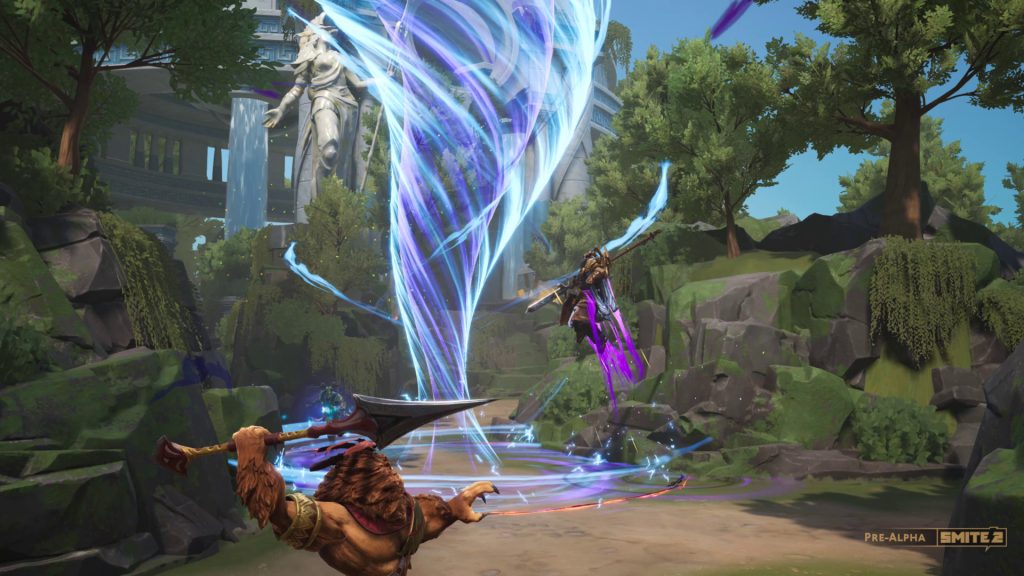
Titan Forge Games, the developer of third-person MOBA title SMITE, has announced the upcoming launch of a sequel, SMITE 2.
The sequel will be accompanied by major changes to the game’s professional esports circuit, including new international LAN events and the end of developer-owned teams.
Soon after the release of League of Legends, which went on to become the world’s leading esport, the developers at Titan Forged Games (a division of Hi-Rez Studios) pondered the question: What if we wanted to play a MOBA but without the RTS point of view? That’s how SMITE was born, a third-person competitive action game that uses the same structure as a MOBA but with over-the-shoulder combat.
After more than 10 years of updates, 130 heroes (themed around gods from humanity’s ancient pantheons) and regular esports tournaments, the developers have decided that it is time for a sequel. Announced live during the ongoing SMITE World Championship in Arlington, Texas, SMITE 2 was announced — and with it major changes to the esports scene.
The main differences between the first and second iteration of SMITE will be a massive migration of everything from Unreal Engine 3 to Unreal Engine 5, a substantial overhaul to some of the games mechanics and, due to the technical changes, the impossibility for the developers to migrate all the paid cosmetics that the users bought from one title to the other. A system called Legacy, however, will be put in place to give those who invested real money in the original the same amount of premium currency for the sequel.
The launch timeline has already been laid out: a spring alpha testing period that will last the whole summer, which will be followed by a beta that will begin in autumn. A final release date is still to be determined, but it may be set for the end of the year.
Meanwhile, 2024 will also be a transitional year for the esports scene that, in a process not dissimilar to the one undertaken by Overwatch when it switched to its sequel, will have to adopt SMITE 2 very early on.
The SMITE esports scene is organised around the developer-run SMITE Pro League circuit. Last year’s World Championship drew 78,000 peak viewers, according to Esports Charts. Despite its modest following, the SMITE Pro League managed to sell out at the Esports Stadium Arlington (with tickets upward of $120 each) for its ongoing 2024 World Championship in Texas, and recently announced several endemic event sponsors.
Now, with SMITE 2, a lot is going to change, starting from early spring. “The SMITE 2 Founders Series will kick off during SMITE 2 alpha testing. We’re currently targeting this Spring for kick-off, but the exact date is TBD,” Alex Cantatore, Executive Producer for SMITE 2, told Esports Insider.

“We will hold competitive, open online qualifying tournaments during alpha playtest weekends and through beta testing. The best performing teams in these tournaments will qualify for LAN Majors with associated prizing,” Cantore continued.
There will be at least two LAN Majors during this initial SMITE 2 Founders Series, with at least one in the United States and one in Europe or the UK. This will mark the first time that competitive SMITE will be played in Europe since 2017.
“We believe this change to a Majors-focused esports scene will be good for the SMITE 2 esports ecosystem, as it’ll remove the restriction for full-time SMITE pro players having to be based in Atlanta. We can see the strength of players who are located in other places in this year’s SMITE World Championship: two of the eight SMITE Pro League teams were defeated by the top EU semi-pro teams in group stages. A third semi-pro team from NA was very close to knocking out another SPL team”.
For the past two seasons, developer Titan Forge Games has owned and operated all SMITE Pro League teams, even assuming responsibility for paying players’ salaries, meaning traditional esports organisations left the scene. As part of that agreement, all players relocated to and competed from Atlanta.
However, the new format will be more open, allowing players to play from wherever and form teams with whomever they choose. Perhaps inspired by the struggles of the franchised Overwatch League, the organisers of the competitive circuit are now also allowing teams to seek sponsors and organisations of their own choosing in this new format. It appears the organisers are leaving this model behind in the hopes of facilitating the rise of a self-sustaining circuit.

“We are a very community-centric developer”, Cantatore said, “and as such we plan to listen to the community during the SMITE 2 Founders Series and continue to evolve the SMITE 2 esports format and ecosystem as the game enters full release.”
SMITE calls itself ‘the console MOBA’ having more than 50% of its player base on consoles and being one of the few esports that has controller optimisation front and centre in its balancing values. This has contributed to a shift in the title’s audience away from fans of traditional MOBAs like League of Legends and Dota 2, and towards fans of action titles like Elden Ring and ability shooters like Overwatch 2 and Destiny 2.
The plan for the SMITE 2 release is to come out in beta with a roster of 50 new and returning heroes that are as new player friendly as possible.
While the first game will remain online and still receive updates but not new heroes, the fancy new graphics, more tutorials and overhauled gameplay loop of SMITE 2 will pair nicely with a revamped esports ecosystem — all with the unified goal of expanding the audience and making the competitive circuit truly global.
